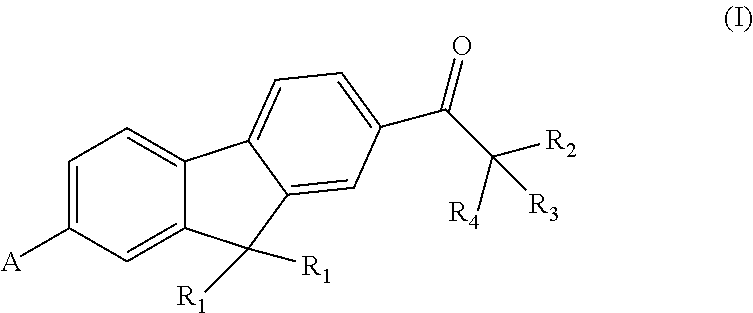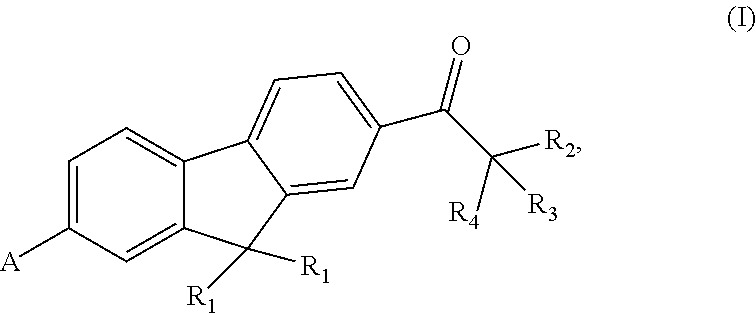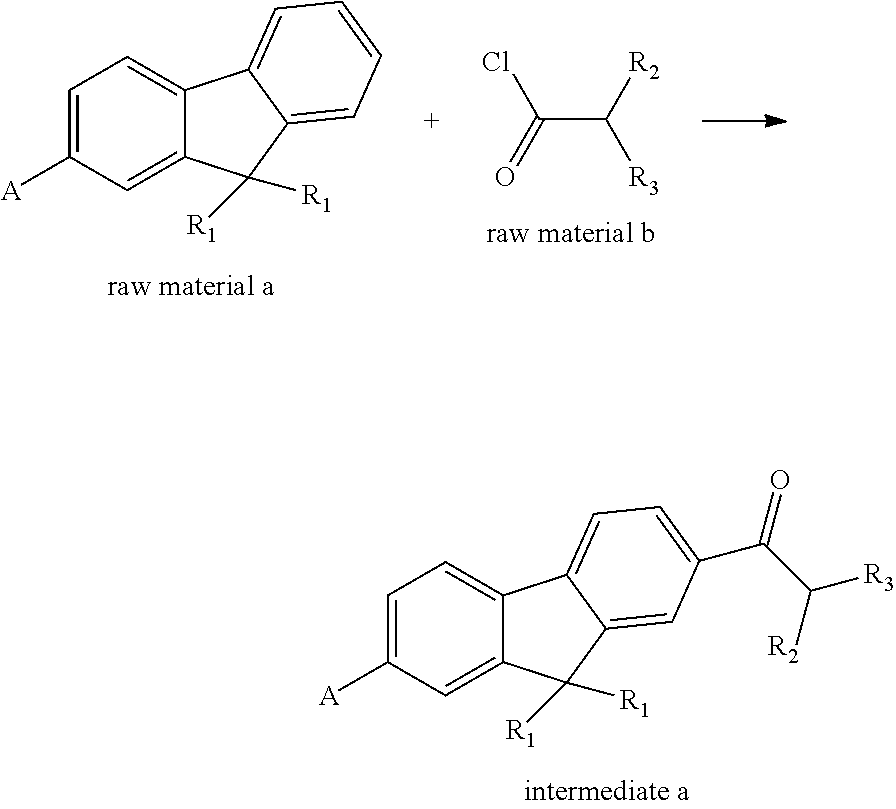Fluorene polyfunctional photoinitiator and preparation and use thereof, and photosensitive resin composition containing fluorene photoinitiator and use thereof
a fluorene polymer and photoinitiator technology, applied in the field of fluorene polyfunctional photoinitiator and the preparation thereof, can solve the problems of generating residues, reducing the linearity of the pattern or peeling of the pattern, and generating significant failures of the photosensitive property of the composition, so as to achieve good curing effect, low exposure dose, and high light sensitivity
- Summary
- Abstract
- Description
- Claims
- Application Information
AI Technical Summary
Benefits of technology
Problems solved by technology
Method used
Image
Examples
preparation examples
Example 1
[0094]
[0095]Step (1): Preparation of Intermediate 1a
[0096]97 g of a raw material 1a, 67 g of aluminum trichloride, and 100 mL of dichloromethane were added to a 500 mL four-necked flask, and the temperature was reduced to 0° C. by an ice water bath. A mixed solution of 54 g of a raw material 1b, i.e., isobutanoyl chloride and 50 mL of dichloromethane was dropped and the temperature was controlled to 10° C. or below, and the dropping was finished in approximately 2 h. Stirring was continued for 2 h after completion of dropping, and liquid phase tracking was performed until the reaction was complete. The materials were then slowly poured with stirring into dilute hydrochloric acid formulated with 800 g of ice water and 100 mL of concentrated hydrochloric acid (37%), and were then poured into a separation funnel to separate a lower layer, which was a dichloromethane layer. 50 mL of dichloromethane was used to continue to wash the water layer. Dichloromethane layers were combin...
example 2
[0108]
[0109]Step (1): Preparation of Intermediate 2a
[0110]106 g of a raw material 2a, 67 g of aluminum trichloride, and 100 mL of dichloromethane were added to a 500 mL four-necked flask, and the temperature was reduced to 0° C. by an ice water bath. A mixed solution of 54 g of isobutanoyl chloride and 50 mL of dichloromethane were dropped and the temperature was controlled to 10° C. or below, and the dropping was finished in approximately 2 h. Stirring was continued for 2 h after completion of dropping, and liquid phase tracking was performed until the reaction was complete. The materials were then slowly poured with stirring into dilute hydrochloric acid formulated with 800 g of ice water and 100 mL of concentrated hydrochloric acid, and were then poured into a separation funnel to separate a lower layer, which was a dichloromethane layer. 50 mL of dichloromethane was used to continue to wash the water layer. Dichloromethane layers were combined, the dichloromethane layer was wash...
example 3
[0120]
[0121]Step (1): Preparation of Intermediate 3a
[0122]111 g of a raw material 3a, 134 g of aluminum trichloride, and 200 mL of dichloromethane were added to a 1000 mL four-necked flask, and the temperature was reduced to 0° C. by an ice water bath. A mixed solution of 107 g of isobutanoyl chloride and 100 mL of dichloromethane were dropped and the temperature was controlled to 10° C. or below, and the dropping was finished in approximately 2 h. Stirring was continued for 2 h after completion of dropping, and liquid phase tracking was performed until the reaction was complete. The materials were then slowly poured with stirring into dilute hydrochloric acid formulated with 800 g of ice water and 150 mL of concentrated hydrochloric acid, and were then poured into a separation funnel to separate a lower layer, which was a dichloromethane layer. 100 mL of dichloromethane was used to continue to wash the water layer. Dichloromethane layers were combined, the dichloromethane layer was...
PUM
| Property | Measurement | Unit |
|---|---|---|
| Time | aaaaa | aaaaa |
| Time | aaaaa | aaaaa |
| Time | aaaaa | aaaaa |
Abstract
Description
Claims
Application Information
 Login to View More
Login to View More - R&D
- Intellectual Property
- Life Sciences
- Materials
- Tech Scout
- Unparalleled Data Quality
- Higher Quality Content
- 60% Fewer Hallucinations
Browse by: Latest US Patents, China's latest patents, Technical Efficacy Thesaurus, Application Domain, Technology Topic, Popular Technical Reports.
© 2025 PatSnap. All rights reserved.Legal|Privacy policy|Modern Slavery Act Transparency Statement|Sitemap|About US| Contact US: help@patsnap.com



